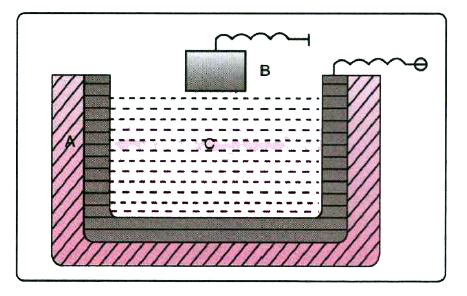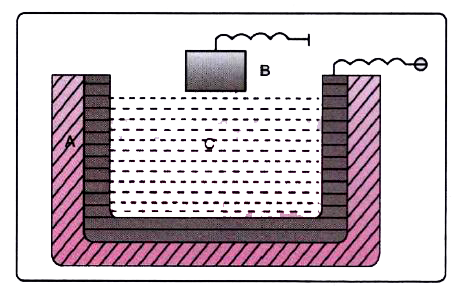In an electrolytic cell, the flow of electrons is form
Cathode to anode in solution
Cathode to anode through externla supply
Cathode to anode through internal supply
Anode to cathode through internal supply
The correct Answer is:C
To solve the question regarding the flow of electrons in an electrolytic cell, we can follow these steps:
Step 1: Understand the Components of an Electrolytic Cell
An electrolytic cell consists of two electrodes: the anode and the cathode, which are immersed in an electrolyte solution. The cathode is negatively charged, while the anode is positively charged.
Hint: Remember that in an electrolytic cell, the charges of the electrodes are opposite to those in a galvanic cell.
Step 2: Identify the Direction of Electron Flow
In an electrolytic cell, electrons flow from the cathode to the anode. This is because the cathode has a higher concentration of electrons, and they are attracted to the positively charged anode.
Hint: Electrons flow towards the positive charge (anode) from the negative charge (cathode).
Step 3: Analyze the Options Given
The question provides multiple-choice options regarding the flow of electrons:
1. Cathode to anode in the solution
2. Cathode to anode through external supply
3. Cathode to anode through internal supply
4. Anode to cathode through internal supply
From our understanding, we can eliminate options that do not accurately describe the flow of electrons.
Hint: Focus on the correct path of electron flow and the nature of the supply in an electrolytic cell.
Step 4: Select the Correct Answer
The correct answer is "Cathode to anode through internal supply." This is because, in an electrolytic cell, the flow of electrons occurs internally between the electrodes.
Hint: Look for the option that correctly describes both the direction of flow and the type of supply.
Final Answer:
The flow of electrons in an electrolytic cell is from the cathode to the anode through internal supply.
An electrolytic cell consists of two electrodes: the anode and the cathode, which are immersed in an electrolyte solution. The cathode is negatively charged, while the anode is positively charged.
In an electrolytic cell, electrons flow from the cathode to the anode. This is because the cathode has a higher concentration of electrons, and they are attracted to the positively charged anode.
The question provides multiple-choice options regarding the flow of electrons:
1. Cathode to anode in the solution
2. Cathode to anode through external supply
3. Cathode to anode through internal supply
4. Anode to cathode through internal supply
The correct answer is "Cathode to anode through internal supply." This is because, in an electrolytic cell, the flow of electrons occurs internally between the electrodes.
The flow of electrons in an electrolytic cell is from the cathode to the anode through internal supply.
Topper's Solved these Questions
Similar Questions
In the electrolytic cell, flow of electrons is form :
View SolutionIn an electrolytic cell current flows
View SolutionFlow of electrons in ETS is
View SolutionWhat is an electrolytic cell?
View SolutionIn an electrolytic solution the electric current is mainly due to the movement of free electrons.
View SolutionElectrolytic cell used for electrolysis of water is known as ..........
View SolutionThe alongside figure is of an electrolytic cell used in the extraction of aluminium.
At which electrode (A or B) is the aluminium formed?
View SolutionThe following is a sketch of an electrolytic cell used in the extraction of aluminium.

At which electrode (A or B) is the aluminium formed ?
View SolutionThe alongside figure is of an electrolytic cell used in the extraction of aluminium.
What are the two aluminium compounds in the electrolyte C?
View SolutionThe following is a sketch of an electrolytic cell used in the extraction of aluminium.

What are the two aluminium compounds in the electrolyte C?
View Solution